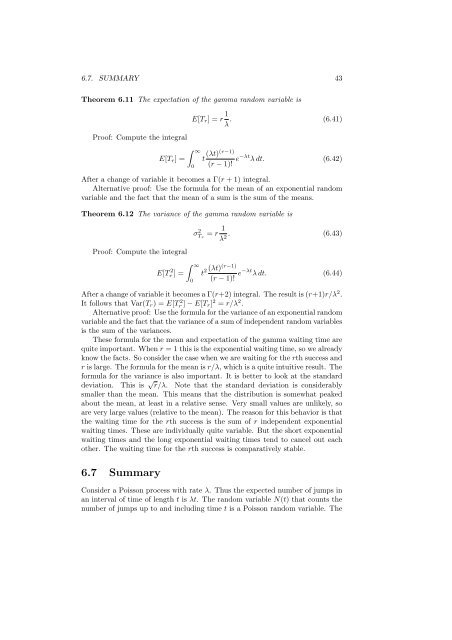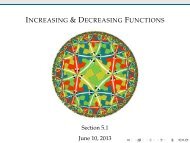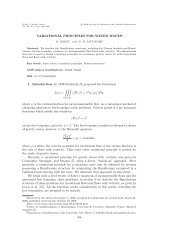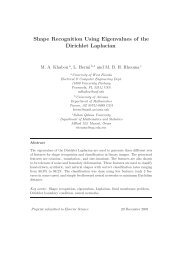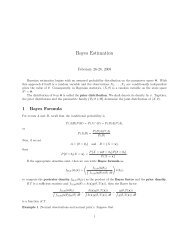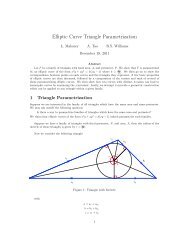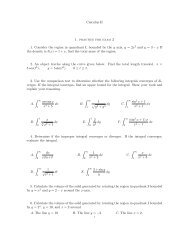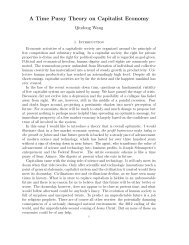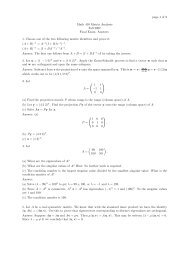Lectures on Elementary Probability
Lectures on Elementary Probability
Lectures on Elementary Probability
You also want an ePaper? Increase the reach of your titles
YUMPU automatically turns print PDFs into web optimized ePapers that Google loves.
6.7. SUMMARY 43<br />
Theorem 6.11 The expectati<strong>on</strong> of the gamma random variable is<br />
Proof: Compute the integral<br />
E[T r ] =<br />
E[T r ] = r 1 λ . (6.41)<br />
∫ ∞<br />
0<br />
t (λt)(r−1)<br />
(r − 1)! e−λt λ dt. (6.42)<br />
After a change of variable it becomes a Γ(r + 1) integral.<br />
Alternative proof: Use the formula for the mean of an exp<strong>on</strong>ential random<br />
variable and the fact that the mean of a sum is the sum of the means.<br />
Theorem 6.12 The variance of the gamma random variable is<br />
Proof: Compute the integral<br />
E[T 2 r ] =<br />
∫ ∞<br />
0<br />
σ 2 T r<br />
= r 1 λ 2 . (6.43)<br />
t 2 (λt)(r−1)<br />
(r − 1)! e−λt λ dt. (6.44)<br />
After a change of variable it becomes a Γ(r+2) integral. The result is (r+1)r/λ 2 .<br />
It follows that Var(T r ) = E[T 2 r ] − E[T r ] 2 = r/λ 2 .<br />
Alternative proof: Use the formula for the variance of an exp<strong>on</strong>ential random<br />
variable and the fact that the variance of a sum of independent random variables<br />
is the sum of the variances.<br />
These formula for the mean and expectati<strong>on</strong> of the gamma waiting time are<br />
quite important. When r = 1 this is the exp<strong>on</strong>ential waiting time, so we already<br />
know the facts. So c<strong>on</strong>sider the case when we are waiting for the rth success and<br />
r is large. The formula for the mean is r/λ, which is a quite intuitive result. The<br />
formula for the variance is also important. It is better to look at the standard<br />
deviati<strong>on</strong>. This is √ r/λ. Note that the standard deviati<strong>on</strong> is c<strong>on</strong>siderably<br />
smaller than the mean. This means that the distributi<strong>on</strong> is somewhat peaked<br />
about the mean, at least in a relative sense. Very small values are unlikely, so<br />
are very large values (relative to the mean). The reas<strong>on</strong> for this behavior is that<br />
the waiting time for the rth success is the sum of r independent exp<strong>on</strong>ential<br />
waiting times. These are individually quite variable. But the short exp<strong>on</strong>ential<br />
waiting times and the l<strong>on</strong>g exp<strong>on</strong>ential waiting times tend to cancel out each<br />
other. The waiting time for the rth success is comparatively stable.<br />
6.7 Summary<br />
C<strong>on</strong>sider a Poiss<strong>on</strong> process with rate λ. Thus the expected number of jumps in<br />
an interval of time of length t is λt. The random variable N(t) that counts the<br />
number of jumps up to and including time t is a Poiss<strong>on</strong> random variable. The


